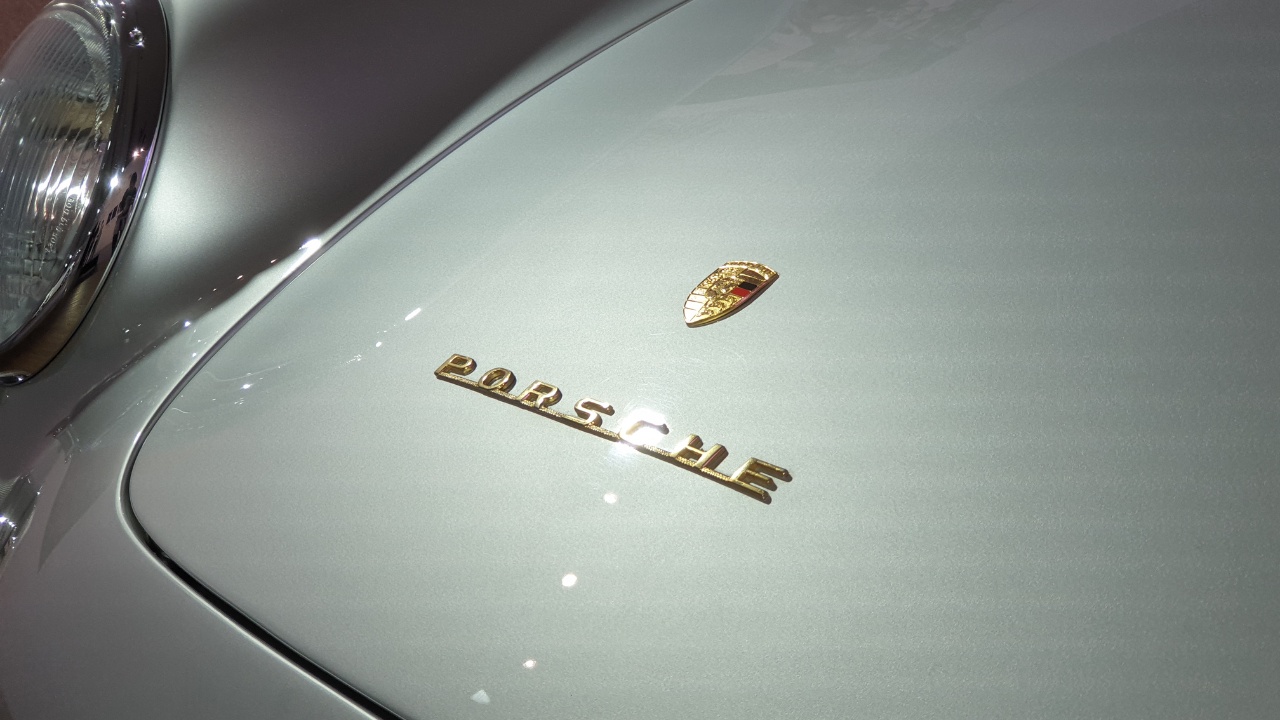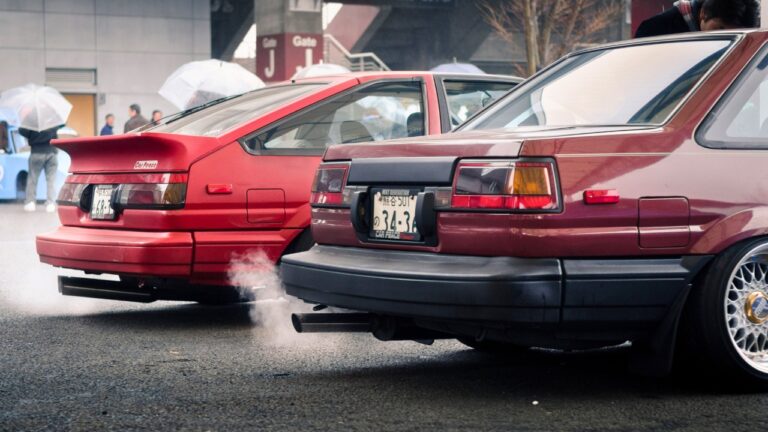24 Best Porsche Cars Ever Built

Porsche was founded in 1931, and since then, the Stuttgart-based carmaker has produced some of the best driver’s cars the world has known.
Picking just 24 Porsche models is a near-impossible task, as some nuggets are guaranteed to be left out.
While this list isn’t comprehensive, we’ve included some amazing cars. They’re not listed in a particular order; some are here because of their importance, others because they’re excellent sports cars.
Porsche 356

Ferry Porsche created the 356/1 in 1948, and it’s the foundation for the sports car company we know and love today. Its aluminum body was designed by Erwin Komenda, and it borrowed some mechanical parts from Volkswagen.
While Porsches’ genesis started with a 1,131cc air-cooled boxer engine producing 40-hp, they soon built sportier versions, such as the 356 Carrera GT Speedster. Its race-bred 1.6-liter quad-cam engine pumped out 160 galloping German stallions.
Porsche 901 (Original 911)

Following the 356, Porsche introduced the 901 in 1963, but since Peugeot had patented the three-digit model designation with a zero in the middle, Porsche changed its name to 911 in 1964.
It had a longer wheelbase, a more compact suspension setup, and a bigger, more powerful boxer engine than the 356. Porsche sold 82 cars with the 901 name, followed by a whopping 111,995 first-gen Porsche 911s over the next decade.
1953 Porsche 550 Spyder

With the 550 Spyder introduced in 1953, Porsche really showed off its minimalistic approach to sports cars. While other sports car manufacturers would use V12 engines, Porsche built a lightweight, race-winning machine around a 1.5-liter boxer engine churning out 108-hp.
Only 90 550 Spyders were made; one was bought by Hollywood actor James Dean, who nicknamed it “Little Bastard.” In 1955, Dean and his Porsche were in a fatal accident, and the car is said to be cursed.
1964 Porsche 904 GTS

The Porsche 904 is one of the carmaker’s most successful mid-engined race cars. It was only built in 1964 and 1965 and was available with multiple engine configurations, ranging from a flat-four to a flat-eight.
This was the first Porsche built on a ladder-frame chassis, and like the brand’s other track-focused models, they kept the weight to a minimum. With the 2.0-liter four-cylinder boxer engine, the 904 weighed just 1,443 lbs and pumped out 180 horses. It could sprint to 60 mph in under six seconds and had a top speed of 163 mph.
1967 Porsche 911R

1967 saw the birth of Porsche’s first homologation special: the 911R, created by Ferdinand Piëch. It had a steel unibody, but all the 911R’s body panels were made from fiberglass by Karl Baur.
The 911R was a huge exercise in weight saving, and by the time they were done, Porsche had reduced its weight by 20% compared to the standard 911. To this day, the 911R is the lightest 911 ever made. They built 23 of them, but unfortunately, after all that work, FIA refused to accept Porsche’s homologation attempt, so the 911R cars could only compete in non-production categories or as rally cars.
2016 Porsche 911 R

1967 wasn’t the only time Porsche built an “R” version of its 911. In 2016, they were at it again. This time, it wasn’t a homologation car; it was what one Porsche executive described as a “car just for a fun day.”
It’s a purist driver’s car with a proper old-school feel thanks to its 4.0-liter flat-six engine and manual gearbox. Thanks to the extensive use of carbon fiber and magnesium, it was the lightest 911 available at the time. Fewer than 1,000 were made, and they cost a fortune today.
1973 911 Carrera RS 2.7

Let’s return to the 1970s and look at the first Porsche with an RS badge. The 1973 Carrera RS 2.7 is an icon and one of the reasons the 911 became so popular among enthusiasts.
It was developed as a race car and received wider fenders, upgraded suspension, and the weight was lowered by using thinner steel and glass. Perhaps most importantly, the 2.4-liter engine was bored to 2.7 liters, producing 210-hp. The Carrera RS could sprint to 60 mph in under six seconds and had a top speed of 150 mph.
1973 Porsche 911 2.8 RSR

Porsche continued to develop the Carrera RS, which resulted in the Carrera 2.8 RSR. It’s developed purely for competition, weighing 176 lbs less than the road-going Carrera RS 2.7, and it’s 2.8-liter engine had around 100 extra horsepower.
The 2.8 RSR is one of the lightest, fastest, and most powerful 911s to have entered in GT racing, which resulted in victories in IMSA, Trans Am, and the 3 Hours at Daytona, among other racing series.
1976 Porsche 911 Turbo (930)

Porsche introduced the first road-going turbocharged 911 in 1976, and it soon became one of the most memorable cars they’ve ever made. Part of that is down to its deadly reputation. It was nicknamed “the Widow Maker” due to its penchant for sending bankers and Wall Street traders off the road.
From 1976 to 1989, Porsche built 21,589 Turbos; 2,891 had the original 3.0-liter engine, and the rest used the later 3.3-liter unit.
1979 Porsche 935

The 935 slant nose is one of the most iconic Porsche race cars. It was developed for FIA Group 5 racing, and privateer teams could purchase them from Porsche.
At the rear, it had an engine derived from the one found in the Porsche 930 Turbo, but in the 935, it produced 650 hp, but it was possible to extract over 800 ponies. Due to the oversized whale tail rear wing, it didn’t take long for the 935 to become known as “Moby Dick.”
1970 Porsche 917K

The Porsche 917 was introduced in 1969, and thanks to its aerodynamic design and flat-12 engine, it dominated races at Le Mans and Daytona. It was built to win, and that’s precisely what it did.
Steve McQueen famously drove a Porsche 917 in the movie Le Mans, and in 2017, that car sold for $14 million. Three of the 917s were converted into road cars, which are estimated to be worth tens of millions of dollars.
2011 911 997.2 GT3 RS 4.0

This may just be the best Porsche RS model ever made. The 2011 GT3 RS 4.0 packs a naturally aspirated flat-six engine, which is the last of the legendary Mezger engines.
With 493-hp, a manual transmission, aero, and plenty of carbon fiber for weight-saving purposes, it’s not just one of the best RS Porsches — it’s among the top driver’s cars ever!
Porsche 911 Turbo (993)

After a couple of decades of widow-maker jokes, Porsche finally gave the 911 Turbo a much-needed AWD setup in 1995. At this point, the Turbo was more powerful than ever, as its engine had grown to 3.6 liters, producing a whopping 402-hp.
The 993 Turbo was now a full-fledged luxury model, with an interior of mostly leather. That meant the driver could lounge in comfort as the car rocketed to 60 mph in under four seconds and on to a top speed of 184 mph. It was the perfect farewell to the air-cooled boxer engine.
2003 911 GT3 RS (996)

While the 996 Porsche’s design isn’t exactly loved, the GT3 RS version is close to sports car perfection. As good as the “standard” 996 GT3 is, the RS version turns everything up to 11.
It’s pretty much a road-legal version of the GT3 RSR race car, with extensive weight-saving measures, such as a polycarbonate rear window and carbon fiber hood and wing. It also had adjustable suspension and the 3.6-liter Mezger flat-six engine. Only 680 were made, and it was never available in the States.
1993 Porsche 964 Carrera RS 3.8

The 964 Carrera RS 3.8 is a limited edition, road-going homologation special based on the Carrera Cup race car. Only 55 cars were built, and they were available exclusively on the European market.
It had the 964 Turbo’s wide body, a massive rear wing, and three-piece Speedline wheels. The engine was a naturally aspirated 3.8-liter boxer unit producing over 300-hp — enough for a 0 to 60 mph time of 4.9 seconds and a 170 mph top speed.
1986 Porsche 959

In the mid-1980s, Porsche introduced the 959 as another homologation special. Rather surprisingly, it was supposed to be a Group B rally car. Unfortunately, by the time the 959 was ready, the Group B class no longer existed, so Porsche decided to race it in the Paris to Dakar rally and at the Le Mans 24-hour race instead.
Porsche stuffed the 959 with tech, including hydraulically height-adjustable suspension, sequential turbos, a crawler gear, and a programmable AWD system, among other stuff. Thanks to its 444-hp, it came very close to the 200 mph barrier, with the speedometer stopping at 197 mph.
2004 Porsche Carrera GT

Gearheads tend to think of boxer engines when Porsche is mentioned, but they’ve also used other configurations. Enthusiasts were shocked and excited when they announced that the Carrera GT would have a V10 unit. The Carrera GT is now known as one of the last analog supercars, and its 5.7-liter engine produces 611-hp and a glorious soundtrack.
It was a handful to keep on the road, and sadly, the Carrera GT is now most famous for Paul Walker’s fatal crash. Before that, it nearly took out Jay Leno during a record attempt at Talladega Superspeedway.
2013 Porsche 918 Spyder

One-third of the “Holy Trinity” of hypercars, the Porsche 918 Spyder is perhaps the best mid-engined Porsche ever made. It’s the company’s first sports car to feature hybrid technology, which helped raise its performance to another level.
Many enthusiasts consider the Porsche 918 the successor to the analog Carrera GT. It doesn’t have a V10 or a boxer engine, instead relying on a naturally aspirated, flat-plane crankshaft V8. When combined with the two electric motors, it produces 886-hp and 944 lb-ft. Reaching 60 mph from a standstill only takes 2.2 seconds.
2018 911 991.2 GT2 RS

Few cars are as scary and impressive as the 2018 GT2 RS, a car built to set lap records — provided the driver is brave enough. Its 3.8-liter flat-six engine produces 700-hp and 553 lb-ft of torque, enough to send it to 60 mph in roughly two and a half seconds. It’ll even demolish the quarter mile in 10.3 seconds and reach a top speed of 211 mph.
As mentioned, it was built to set lap records, not for cruising leisurely on the Autobahn, and it lapped the Nürburgring Nordschleife in just 6:47.3.
Porsche 911 GT1 Straßenversion

You can tell that the Porsche 911 GT1 Straßenversion is a homologation special just by looking at it, there’s no need to read its specs. It looks like a Le Mans racer, and that’s because it is — the road-legal version received minimal changes from the actual race car.
Besides the headlights, the Porsche 911 GT1 Straßenversion is nothing like the 996 version 911. With 540-hp and 443 lb-ft of torque, the 911 GT1 road car was unbelievably powerful in the late 1990s. It could hit 62 mph in just 3.8 seconds, which was practically unheard of back then.
Porsche 718 Cayman GT4 RS

The 718 name is now used on the Cayman and Boxster, and it’s a reference to the legendary 718 race car built between 1957 and 1962. Like the original 718, the new GT4 RS models are lightweight, mid-engined cars built to outmaneuver heavier and more powerful competitors.
The mid-engine layout gives the Cayman (and Boxster) GT4 RS optimal weight distribution. With a flat-six engine pumping out nearly 500-hp and a 7-speed dual-clutch gearbox, these cars are as fast as the racing-inspired aero will have you believe. Zero to 60 mph is dealt with in just over three seconds, and top speed is just under 200 mph.
Porsche Taycan

Enthusiasts expect a certain look and performance when they purchase a Porsche, and while the Taycan is the manufacturer’s first EV, there’s no mistaking it for anything else. It both looks and drives like a P-car should.
Like Porsche’s other mainstream models, it’s just as good during the daily commute as it is on twisty backroads. The flagship Turbo S model has two electric motors producing 751-hp and 774 ft-lb, making it one of the world’s fastest-accelerating vehicles. It even offers a range of 345 miles on a single charge.
Porsche 924 Carrera GT

The 924 Carrera GT certainly isn’t the best-known Porsche homologation special, but it’s still a fantastic machine. Exterior-wise, it’s got wide fender flares and a large hood scoop, making it look much more aggressive than the regular 924. In fact, it looks more powerful than it actually is.
Its engine was still the VW-derived inline-four, but it now produced 210 hp. It became hugely popular when it was first unveiled. Homologation rules stated that Porsche had to build 400 cars, and they sold over 250 of them before the 924 Carrera GT even entered production.
1996 Porsche Boxster

When Porsche released the first-gen Boxster in 1996, enthusiasts were quick to label it “a poor man’s Porsche,” but in reality, it was an excellent driver’s car thanks to its mid-engine layout. Later Boxster S models with the 3.2-liter engine even packed a decent punch.
However, we’ve included it on this list mainly because it was one of the models that saved Porsche from bankruptcy in the mid-1990s.





